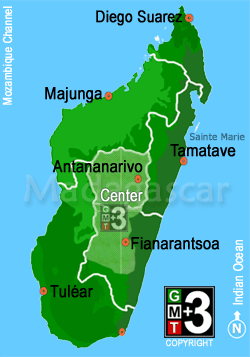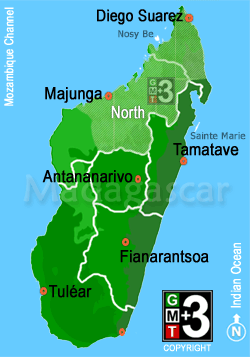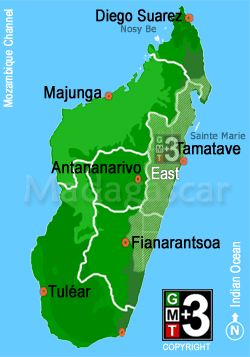CLIMATE OF MADAGASCAR
GENERAL INFO
There are five main regions, which possess their own climates and attractions. Most visitors are unlikely to have enough time to visit every region so it is important to plan your trip around the different attractions and climates. Rainfall patterns vary widely between regions and, at times of high rainfall, travel is difficult, if not impossible. The five climatic regions are the highlands, the south, the north, the east and the west.
CLIMATE SUMMARY
The climate of Madagascar is subtropical, with a hot and rainy season between November and the end of March (summer), and a cooler dry season from May to October (winter). However, at all times of the year there is a big temperature variation depending on altitude and geographical position. The west coast is drier than the east coast, whilst the far south and southwest is a semi-desert region that experiences very little rainfall. Temperatures are much cooler in the highlands. Night temperatures in Antsirabe can descend below 5°C, so make sure you bring a warm pullover. Antananarivo has a pleasant, temperate climate thanks to its 1300 m altitude. Along the coast temperatures are much higher than in the capital and range from 27°C to 32°C in the wet season and 18°C to 22°C in the dry season. If you are travelling to the Eastern region, do not forget your rain gear: heavy rainfalls can happen at any time of the year. On the Masoala Peninsula and around Maroantsetra, the wettest months are from July to September. You can find more specific information about the different climatic conditions in Madagascar in the sections dedicated to each zone in this travel guide. Please see the details about: The Highlands, The South, The North, The East and The West.
CLIMATE PER REGION
HIGHLAND CLIMATE IN MADAGASCAR
The altitude of the highlands influences the temperature and rainfall. In general, temperatures are not as hot here as in the coastal regions and can vary up to 20°C between day and night-time (25°C to 5°C in the coldest nights). This is especially pronounced between June and September, so do not forget to bring warm clothes with you! The rainy season starts in November and lasts until March or April and is also the hottest period in the highlands, with an average temperature of 28°-30°C |
|

|
SOUTHERN CLIMATE IN MADAGASCAR
This arid region has a dry tropical climate with very little rain. The only period when it might rain is from January to March. The rest of the year is almost completely dry, especially on the southwestern coast South from Tulear, which is the driest area of the country. The eastern part around Fort Dauphin sees a little more rain, but it is still very dry. Temperatures get really high from February to May and between October and December (30° average), so be prepared for a burning sun during this period. The nicest period is during the winter, from June to September, when the temperatures are around 25°C. |
|

|
NORTHERN CLIMATE IN MADAGASCAR
There are several climatic areas in the northern part of the island. In the north-western coast around Mahajanga there are two clear opposite seasons, a dry and warm period from May to November (20°C average) and a rainy and sometimes much hotter season from December to April, when temperatures reach more than 35°C. North from Mahajanga along the West coast, the Tsaratanana massif is responsible for a micro-climate named after the main river in this area, Sambirano. Thus, this region and the islands around Nosy Be have the two seasons mentioned above as well, but rainfall is more evenly spread throughout the whole year. That means that it does not rain as much during the rainy season but it does often rain during the dry period. Temperatures are warm all year around, with an average temperature of 25°C. Northeast, on the opposite coast, the stable dry climate that dominates North Madagascar during the austral winter, abruptly changes. Although the period between May and November is in fact drier than the rest of the year, it can rain at any time. The months with the heaviest rainfalls are January, February and March. Rain can be torrential and as this is the cyclone. |
|

|
EASTERN CLIMATE IN MADAGASCAR
The eastern part of Madagascar is the wettest region of the island. The tropical humid climate is responsible for the constant rainfalls, although the amount of rain decreases while moving southwards. The “dry” season lasts from August to December, although a shower usually falls almost every day, so do not forget your rain gear when coming here! During the rest of the year, the months where it rains the most are February and March. The cyclone season lasts from the end of December till March. Please avoid a visit during these months because the cyclones can be very destructive and roads are often impassible. The hottest months, with an average temperature of 30°C, are March, April and December. Temperatures are cooler during the rest of the year, usually between 20° to 28°C on average. Only during August and September does the thermometer go below 20°C, and it can get even a little colder during the nights.. |
|

|
WESTERN CLIMATE IN MADAGASCAR
The western coast of Madagascar is much drier than the eastern coast. In general, we can say the climate here is dry tropical. During the dry months between May and November it does not rain at all and the temperatures are pleasant (20 to 25°C on average). Between December and April it can rain torrentially or just a couple of showers, depending on the area and the year. The northern area is greener and indeed considerably wetter than the south. The hottest months are March, April, November and December, when the average temperature is 30° C or even more.. |
|

|
|